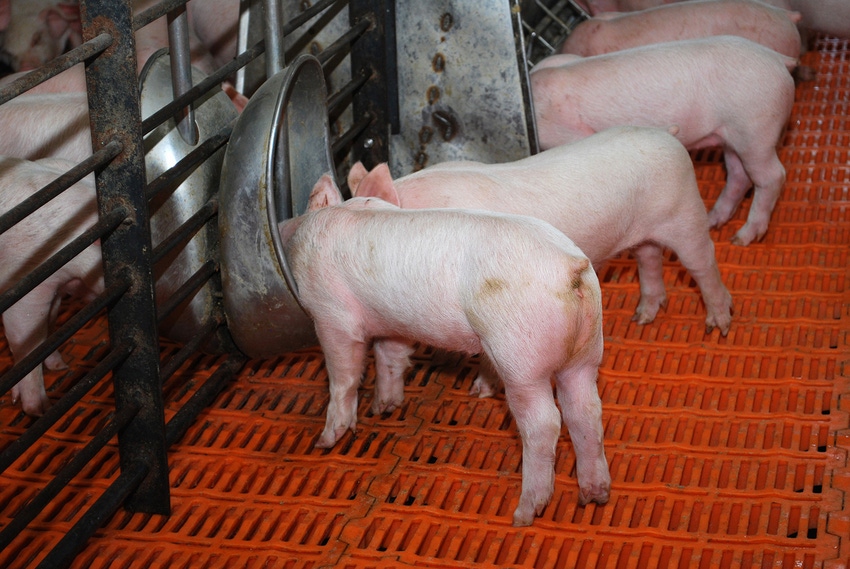U.S. livestock water investments dropped 36% from 1960 to 2016
Study finds United States produced pork nearly four times more water-efficiently in 2016 than in 1960.
February 24, 2020

Six decades after pouring water into its livestock production, the United States is investing relative drops in the bucket to produce its meat, milk and eggs, says a recent analysis from Nebraska's Daugherty Water for Food Global Institute.
Relying on data from the USDA and other sources, the team analyzed the annual U.S. outputs of beef, pork, poultry and milk from 1960 to 2016. The researchers also estimated the yearly amounts of water invested in each class of livestock: the rainfall and irrigation needed to grow grains and other livestock feed; the drinking water those livestock consumed; the water used to clean the animals and their living quarters.
By dividing the annual weight of each livestock product by the volume of water needed to produce it, the researchers then calculated water productivity, a per-animal measure of how efficiently U.S. producers converted water into food.
They found that U.S. water productivity for all six livestock products — beef, pork, chicken, turkey, milk and eggs — improved incrementally but substantially across the 56-year span. The United States produced milk about five times more water-efficiently in 2016 than in 1960; pork nearly four times more efficiently; chicken, turkey and eggs, collectively, about three times more efficiently; and beef about twice as efficiently. Annual water investments in that U.S. livestock dropped 36% from 1960 to 2016, the study reported.
Nebraska's Mesfin Mekonnen, the study's lead author, said the projected rise in global population — from an estimated 7.7 billion to nearly 10 billion people by 2050 — will continue to demand improvements in water efficiency.
"Globally, we see that the population is growing, income is improving, and with that, the demand for livestock products is increasing," says Mekonnen, research assistant professor with the Water for Food Institute. "When comparing a livestock product to a nutrient-equivalent crop product, livestock demands more water. So with the increase in demand for animal products, there will be more water demand, creating more pressure on the limited available water."
The recent improvements in water productivity, Mekonnen said, likely stem from a few factors. A combination of selective breeding, genetic engineering and supplements have increased the sheer size of the average livestock, he said, generally resulting in more food from each animal.
But similar efforts have also improved the efficiency with which livestock convert their own feed — usually grains, grasses or their byproducts — into meat, milk and eggs. While the total weight of U.S. livestock products increased 48% over the 56-year period, the weight of their feed rose by just 8%, the study found. And many of the grains that constitute livestock feed have themselves been bred or modified to require less water than they did a few decades ago, directly reducing the industry's water footprint.
Though the water efficiency of beef improved the least among the livestock products — beef cattle account for nearly half of the U.S. livestock industry’s water footprint — Mekonnen emphasized the importance of context when evaluating consequences for the environment and food security. Many cattle, particularly those in the Nebraska Sandhills, forage on grasses that are inedible by humans and grown on rangelands ill-suited for other crops.
Mekonnen did cite the diets of grain-fed cattle and other livestock as targets for further improving water productivity. The team reported that swapping out some corn and soybean for so-called distiller grains — byproducts of the grains distilled for biofuels and other purposes — could improve the water productivity of milk by roughly 20%, pork by more than 10%, and beef and poultry by about 5%. Because distiller grains can contain more protein and provide more energy than corn and soybean meal, they might also indirectly improve water productivity via livestock growth, Mekonnen says.
"It creates the awareness that we need to look at the full supply chain when we talk about livestock or other products — from feed production to the final output," he says. "We cannot say, 'This is enough.' There is a need to keep on improving."
The team detailed its findings in the journal Environmental International. Mekonnen authored the study with the late Arjen Hoekstra, formerly of the University of Twente, along with Nebraska's Christopher Neale, professor of biological systems engineering and director of research at the Water for Food Global Institute; Chittaranjan Ray, professor of civil and environmental engineering and director of the Nebraska Water Center; and Galen Erickson, Nebraska Cattle Industry professor of Animal Science.
Source: University of Nebraska Institute of Agriculture and Natural Resources, which is solely responsible for the information provided, and wholly owns the information. Informa Business Media and all its subsidiaries are not responsible for any of the content contained in this information asset.
You May Also Like



